Top 6 Best Revenue Attribution Tools
Marketers are no longer interested in crediting the entire conversion to the final ad that the customer saw before purchase. Instead, they want to know how different touchpoints in the customer journey impact revenue.
With revenue attribution, they can understand which campaigns and marketing activities lead to the highest engagement and conversions. Over time, this directs the marketing budget and resources to the sources that generate the most revenue.
The use of revenue attribution is becoming increasingly common, with 76% of marketers who say they currently use revenue attribution or will have the capability to use it within the following 12 months.
To learn why B2B SaaS businesses invest in revenue attribution, what models they use, and the best attribution tools in the market, read on.
In a rush? Skip to the first tool!
Why is Revenue Attribution Important?
Unlike B2C sales, the sales process for B2B SaaS is complicated. It involves various decision-makers, touchpoints and pathways, requires continuous engagement and can take months before a conversion is made. With too many things to focus on, conversion tracking alone is not enough to understand how each marketing action affects revenue. That’s why B2B marketers use revenue attribution.
Revenue attribution helps businesses connect a sale with the campaign, channel, keyword, or ad that influenced it the most. Unlike conversion tracking, which deals with specific actions, revenue attribution connects all the touchpoints in the customer journey. Then it assigns the revenue back to these touchpoints.
There are many benefits you can get through revenue attribution:
1. Better marketing campaigns
Revenue attribution helps B2B SaaS businesses understand how campaigns influence prospects and customers. Knowing how customers receive marketing efforts on different channels or sources is valuable; it helps optimize campaigns for better future performance, resulting in more leads and ROI.
2. Improved marketing spend
Using attribution models, you can understand the touchpoints that lead to the highest engagement and revenue. This allows for more informed budgeting and media spending. It also means you will spend less time and effort on unrewarding marketing activities.
3. Marketing and Sales Alignment
Transferring revenue attribution data from marketing to sales reps help sales prioritize and close deals more effectively.
How Many Attribution Models Are There?
There are plenty of attribution models available. The model that you choose will depend on your business, product, and customers’ buying habits. Here is a complete breakdown of all the attribution models:
- First-touch
This model assigns 100% of the credit to the first interaction a user had before conversion. It ignores any touchpoints between the first click and the conversion. Evaluating first-touch for different channels is a great way to attract new customers to the top of the funnel.
2. Last-touch
This model assigns 100% of the credit to a user’s most recent interaction before conversion. It assumes that the final interaction of the users is what drove the conversion. This model also ignores many critical touchpoints a user goes through, so it’s most helpful if the journey from exposure to conversion is short. Many platforms, including Google Analytics, use last-touch by default.
3. Linear
Unlike first and last interaction, linear attribution considers all the touchpoints. It assigns equal credit to every touchpoint that the prospect goes through. This model provides a better way to understand the success of your marketing campaign across different channels. However, it assumes that each touchpoint is equally important in driving a conversion, which is unrealistic.
4. Last non-direct click
This model assigns 100% of the credit to a user’s most recent interaction before conversion while ignoring direct traffic. This model emphasizes the marketing activities you can control, such as PPC. Similar to first and last-touch, it ignores any other touchpoints.
5. Lead creation
This model assigns 100% of the credit to the interaction that makes the prospect a qualified lead. Businesses may use this model since becoming a lead is a crucial step in the path to becoming a customer. Moreover, the performance in the lead creation step shows how well the marketing strategy is working.
6. Time decay
In this model, the most recent interactions are given more credit than the previous ones. This model assumes that the final interactions have the most significant influence in driving a purchase. Since this model provides the least consideration to top-of-the-funnel marketing activities, it is most suitable for businesses with a lengthy sales process.
7. U-shaped
Also called position-based, this model gives more credit to the first and last interactions before conversion. With this weight distribution, the top and bottom of the funnel activities get the highest value. Meanwhile, interactions in between are not ignored either. The U-shaped model is most suitable for businesses with a long sales process and many interaction points.
8. W-shaped
The W-shaped model gives the most credit to the first, last, and middle touchpoints, while the remaining credit is distributed evenly among the rest of the touchpoints. The most critical interactions in a conversion journey are highlighted: from the first milestone to the point of lead generation and finally to the last milestone before conversion.
9. Z-shaped
This model gives credit to every touchpoint. It assigns 22.5% of the credit to each of first touch, lead generation, opportunity creation, and last touch. It assigns the remaining 10% to touchpoints in between.
10. Algorithmic or Data-Driven Attribution
This is a model in Google Analytics that uses data to algorithmically determine the campaigns, ads, and keywords that have the strongest influence on conversion. However, it is better for a large volume of conversions, and it’s only available in Google Analytics 360 (the paid version).
11. Custom Attribution
This model lets you determine the weighting of each interaction leading up to a conversion. It’s best for businesses with a lot of data and a long buying process.
In the following section, I’ll go through the top revenue attribution tools that help you assess the success of your marketing campaigns and channels by attributing conversion credit to different sources.
HockeyStack
HockeyStack is a SaaS analytics platform trusted by 6600+ companies.
HockeyStack unifies your marketing, product, revenue, and sales data to uncover what drives revenue & also has revenue attribution features.
You might be thinking “We are using Segment for that.” Well, Segment is awesome as a CDP, but not as a SaaS analytics platform as tools that you are using don’t send critical metrics to each other, even with Segment.
For example, if you are using Profitwell, Mixpanel, and Google Analytics & connect them with Segment, you’ll not be able to understand which blog posts bring the highest LTV and the most engaged customers.
Why? Because Profitwell doesn’t send LTV data to Mixpanel, Mixpanel doesn’t track referrers automatically, and you are not able to uncover whether your content marketing game is strong or what drives revenue, engagement, or growth for your SaaS.
HockeyStack tracks everything automatically on your website and product using a cookieless script with no code and no setup. Then it connects with your SaaS platforms with native integrations.
Pro Tip:
Click on an image to see the report live!
You can create any report you need with every single metric you have from scratch using no code, or you can also get started with your pre-made dashboard templates.
For example, you can build a churn by the blog post user signed up report:

A report to measure the exact revenue you get from blog posts:

Reports to measure customer success team’s effect on growth:
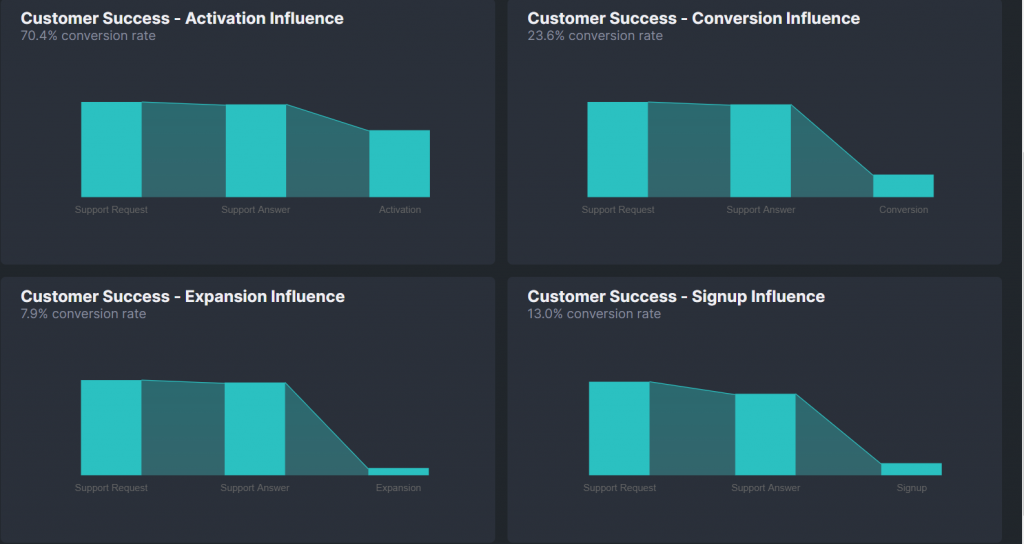
A trial to expansion funnel:

An engagement by feature report:

Or an active users report:

On top of custom dashboards, HockeyStack has other features too, such as
- Surveys (free for everyone)
- Step-by-step user journey
- Funnels & goals
- Revenue Attribution
and more.
HockeyStack Pricing
HockeyStack has two plans, both of which have a 14-day trial with a 30-day refund guarantee.

You can check out the pricing page here.
HockeyStack Integrations
- Paddle
- Stripe
- Hubspot
- Crisp Chat
- Mailchimp
- Intercom
- Pipedrive
- Chameleon
- Salesforce (coming soon)
- Zapier (coming soon)
HockeyStack Summary
The unique benefit of HockeyStack is its ability to unify your marketing, revenue, sales, and product data using no code. This allows you to uncover unique insights that you wouldn’t be able to by using multiple tools as they cause you to have fragmented data.
- You can integrate with Stripe, Paddle, Hubspot and other SaaS platforms to build every single dashboard that you can think of, using all sales, marketing, revenue, and product metrics.
- You can create funnels, goals, and surveys, which are rare to get with other tools on this list.
- You don’t need any developers, tracking is cookieless, and the script is small, so it doesn’t increase your site loading time.
Bizible
G2 Rating: 4.7/5
Bizible is a marketing attribution software founded in 2011 that focuses on the performance of marketing channels. It uses multi-touch attribution and reporting to provide insight into what channels lead to the conversion of visitors. This information is helpful to discover your most engaging channels and improve your marketing spending.
Bizible Features
Here are the main features of Bizible:
1. Touchpoint Tracking
The data model of Bizible is touchpoint-based, which enables you to see the entire B2B buyer’s journey. You can track every account, opportunity, buyer, and funnel stage. Moreover, you can see from the first anonymous touch to closed revenue.

2. Attribution Modelling
These features deal with the attribution of revenue, pipeline, and ROI to different channels, campaigns, and other sources. You can also customize your attribution through channel names, stage names, and weighting. Bizible also offers advanced attribution features – such as ABM attribution – that you can use as your company grows.

3. Analytics & Reporting
For quick answers and analysis, Bizible offers dashboards that are easy to configure and use. These dashboards give insight into revenue, ROI, funnel velocity, pipeline attribution, and more.

Bizible Pricing
Bizible doesn’t provide pricing information. To request pricing, you need to fill out the form on Bizible’s webpage.
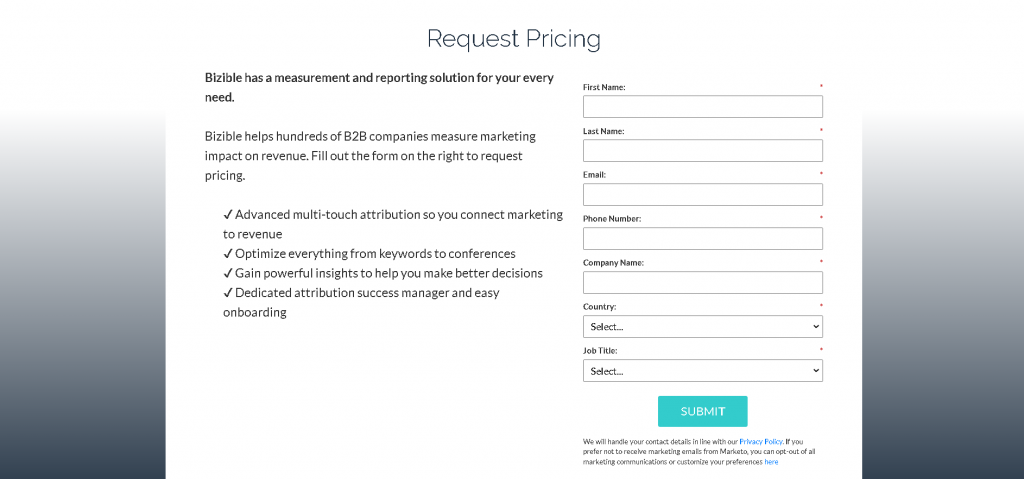
Neustar
G2 Rating: 4.0/5
Neustar is an American information services and technology company founded in 1996. It provides real-time data and analytics for a range of different industries. The solutions provided by Neustar include marketing, risk, security, registry, and communications. The company has over 8,000 clients worldwide across four continents.
Neustar Features
Some of the main solutions from marketing are customer analytics, customer experience, and customer intelligence.
1. Customer Analytics
These include solutions that help you better analyze your marketing campaigns. For example, the unified analytics feature enables you to combine cross-channel analytics of marketing mix modeling with real-time insights of multi-touch attribution.
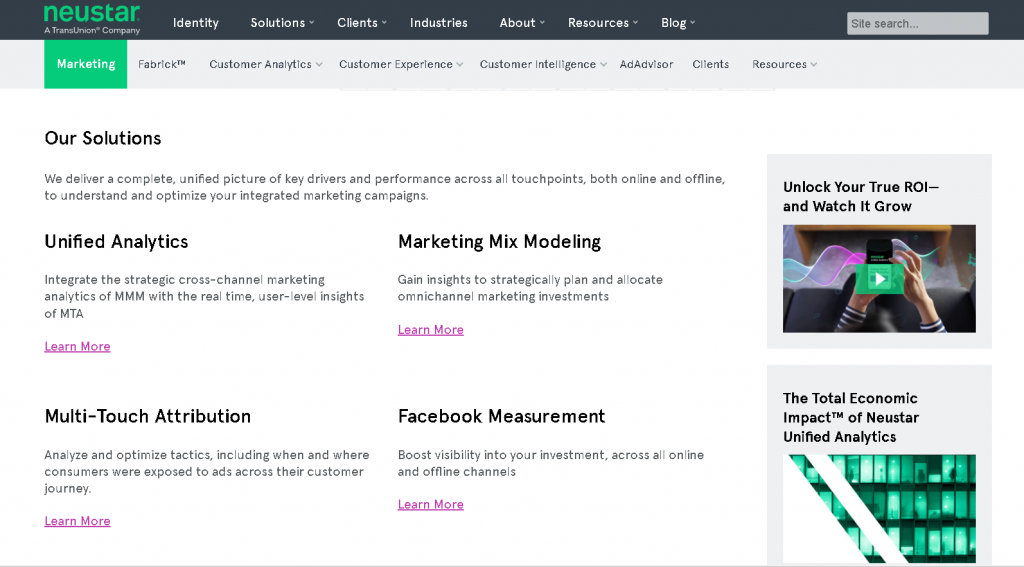
2. Customer Experience
These features enable you to measure users’ propensity to buy across different platforms, understand your marketing performance, and better serve your most valued customers.

3. Customer Intelligence
Some of the features in this area are customer scoring and segmentation, identity management, and lead intelligence. They help you understand your users through accurate data across different platforms, channels, and devices.

Neustar Pricing
Neustar does not disclose pricing information.
Attribution
G2 Rating: 4.5/5
Attribution provides marketing attribution, affiliate tracking, and data exportation for B2C and B2B marketers. The multi-touch attribution uses automatic data collection and offers customizable models and intuitive reporting. This model can also be used for affiliate marketing, another solution offered by Attribution. Attribution was founded in 2014 by Gideon Baldridge and Samuel Reh.
Attribution Features
1. Multi-Touch Attribution
The multi-touch attribution feature provides visibility across touches, channels, and accounts. Its interface is intelligent, easy to set up, and has useful advanced visualizations. With this feature, you can
- identify overlapping campaigns
- access full user history
- compare ROI by channel and campaign
- see the full journey to conversion
- customize your attribution models

2. Affiliate Tracking
This feature is for tracking your affiliate marketing. It helps you manage affiliates and create offers and payout models. You can measure and track all the impressions, clicks, and conversions and identify the top-performing links and pages. The data gathered through affiliate tracking helps you scale your best affiliate campaigns and increase their returns.

3. Data Export Tool
This tool is for exporting marketing data. It provides data analysts, scientists, and engineers complete access to sessions, visits, campaign levels, and marketing spending. After building customer reports and tracking the data, you can export it to software such as S3 or Google Cloud Storage.
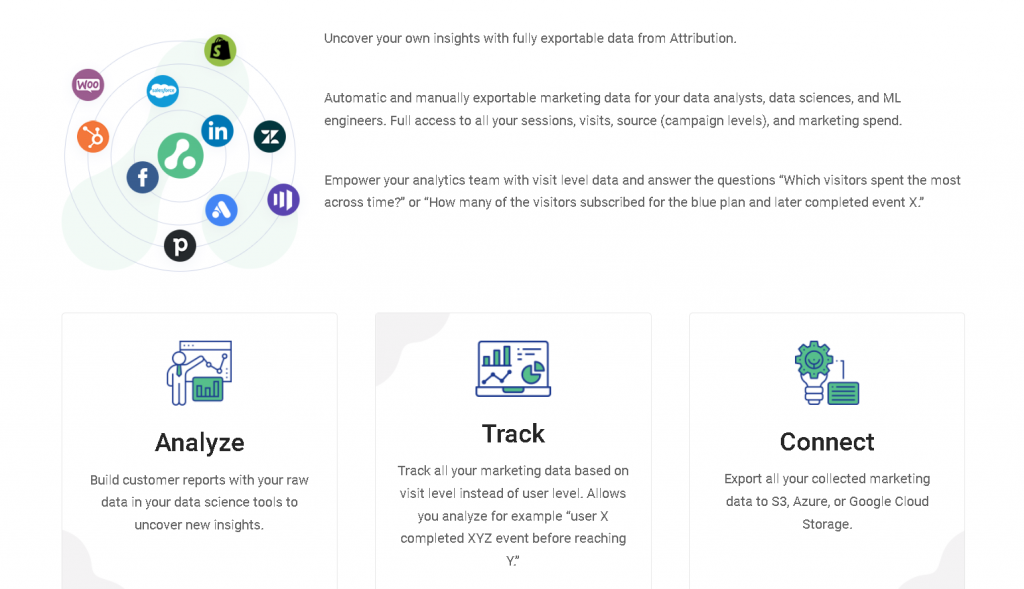
Attribution Pricing
Attribution’s pricing is based on the number of conversion events tracked per month. These include sales, lead generations, and registrations.
There are four pricing plans :
- Small tracks 500 conversions/month at $60/month
- Medium tracks 1,500 conversions/month at $100/month
- Large tracks 5000 conversions/month at $200/month
- Custom has custom pricing and conversions per month
Each plan provides access to a certain list of features. You also get a 15-day trial for each plan after installation.
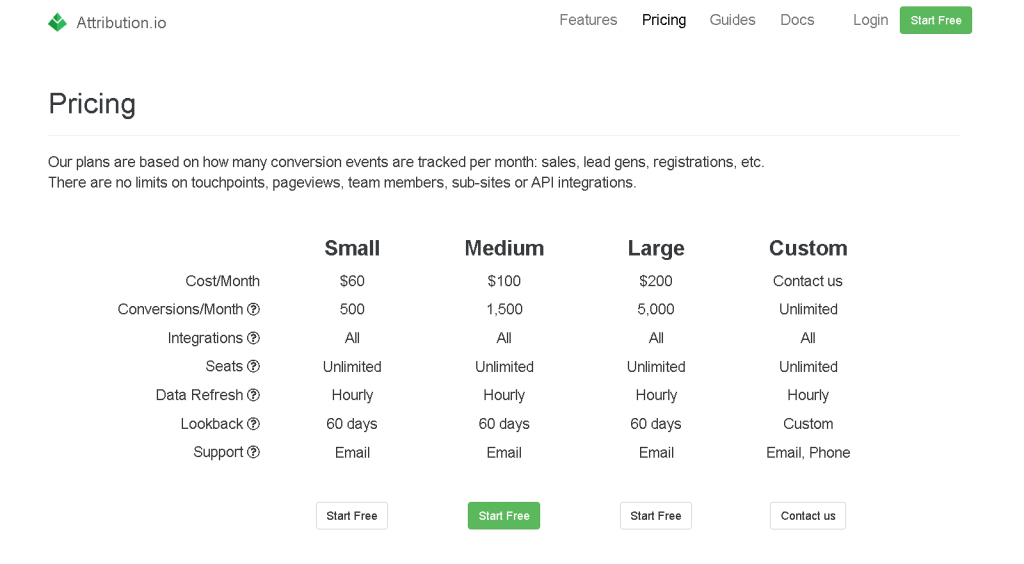
Adjust
G2 Rating: 4.4/5
Adjust is a marketing attribution platform that focuses on mobile attribution. It attributes users to the source marketing channels, measures marketing touchpoints, and provides real-time reporting and unlimited access to data.
Adjust was founded in 2012 to help marketers understand their app’s users in a better way.
Adjust Features
Some of the key features of Adjust are:
1. Attribution
The attribution feature lets you better understand the user journey through different channels, customize your attribution and track your subscription funnel in a single location. It also helps you discover your best ads and send deep links to app users to increase conversion.

2. Analytics
The analytics tools of Adjust provide real-time app analytics on its dashboard. You get full visibility into user lifecycle, uninstall and reinstall tracking, multi-touch tracking, and event tracking. The Adjust Data Canvas provides customizable charts to simplify analysis when the dashboard gets overwhelming.
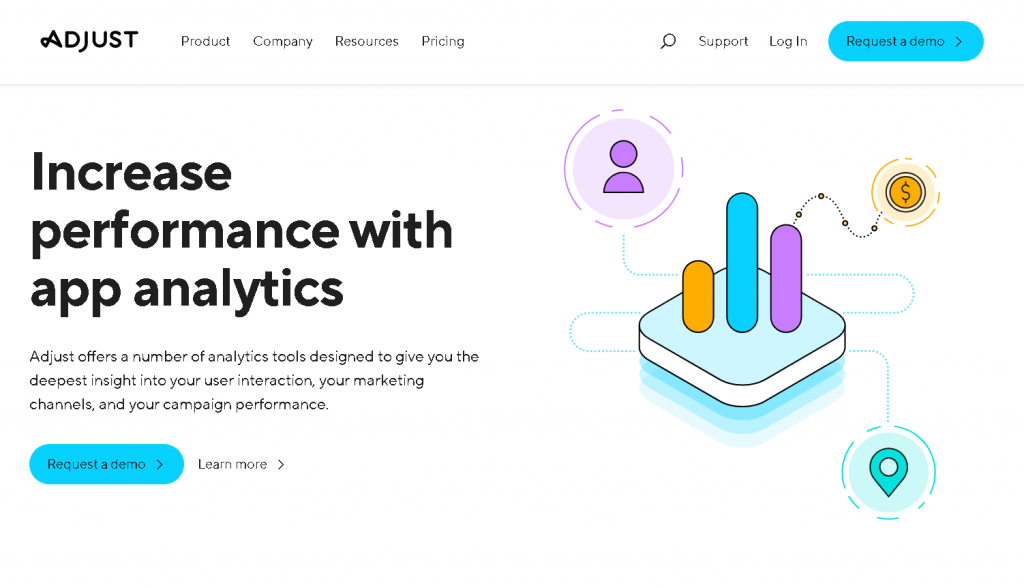
3. Data Access
Adjust provides unlimited access to raw data at any time. It also has no user duplication, which prevents you from paying for the same user.
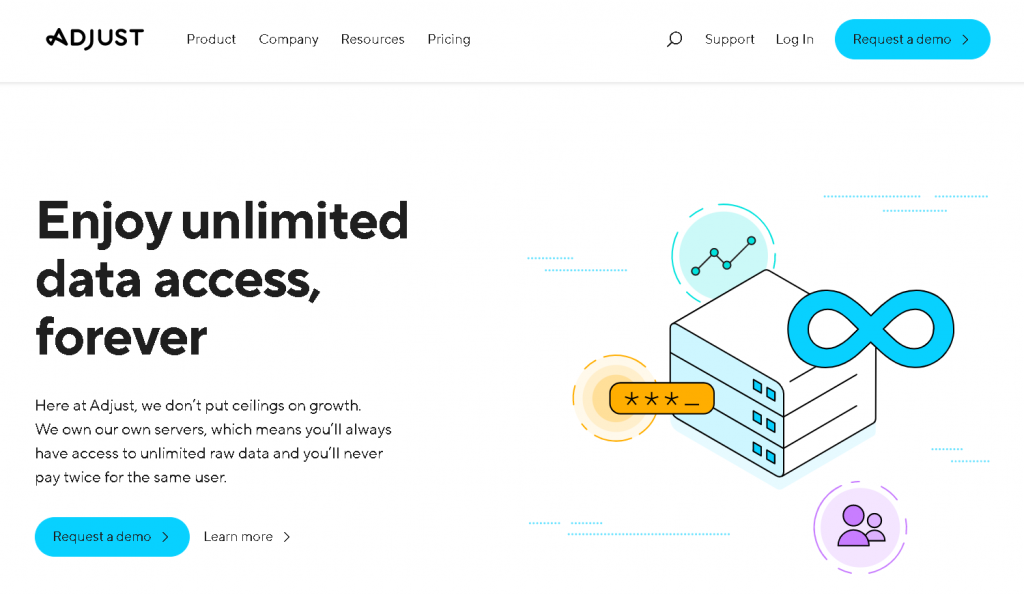
Adjust Pricing
The pricing of Adjust is based on attributions. The Base plan is free and it’s for up to 1,500 monthly attributions. The Core plan is for up to 250,000 annual attributions. And the Enterprise plan is for over 250,000 annual attributions. For Core and Enterprise plans, there is no pricing information.
All plans include attribution and measurement, analytics and reporting, security, compliance, support, and growth features.
Impact
G2 Rating: 4.6/5
Impact is a partnership management platform founded in 2008, based in California, United States. It helps businesses manage several types of partnerships, including affiliates, influencers, mobile, sponsorships, B2B, and ambassadors.
Businesses use the Partnership cloud to manage partnerships with Impact. This platform takes partnership managers through a six-step journey into the building and maintaining a relationship with their partners. It starts with the discovery and recruitment of the ideal partner and ends with optimizing the relationship.
Impact Features
Here are some of the key features of Impact:
1. Influencer marketing
These features help you manage your relationships with influencer partners. You can build your commission plan based on custom parameters, form direct relationships with influencers, and use analytics to identify the best-performing influencers.
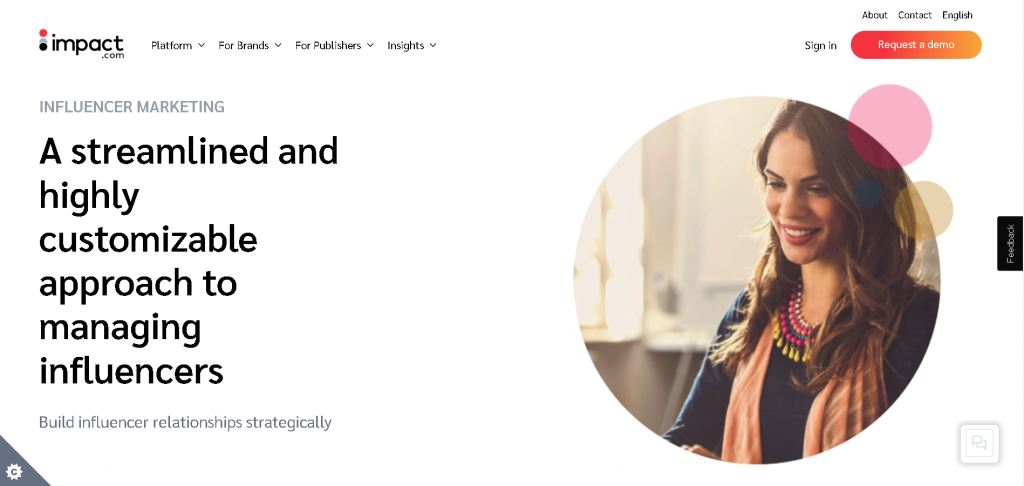
2. Analytics and attribution
This feature includes data onboarding, which lets you track your data in real-time. The data is then cleansed and verified for higher accuracy and a clearer view of the user journey. Impact also provides cross-device identification and brings together both offline and digital performance.
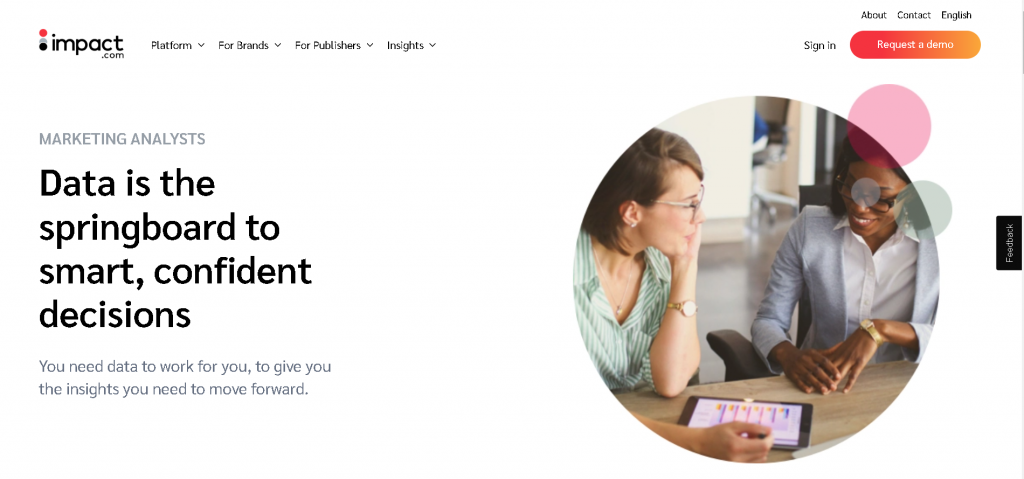
3. Affiliate marketing
This solution assists in expanding your current affiliate network. It also provides a space to discover and connect directly with new partners around the world. You can also track and analyze customer performance metrics and identify affiliate fraud across different platforms.

Impact Pricing
Impact does not offer pricing information on its web page.
Conclusion
Revenue attribution helps companies understand how different campaigns and channels affect revenue and optimize their budget for better performance and increased ROI.
Several attribution models give different weighting to touchpoints in the customer journey. To really understand the impact of different campaigns, it’s important to choose the model that best aligns with your business. The revenue attribution tools listed above track marketing channels and use attribution modeling to help you identify the best-performing marketing activities.
FAQ
Yes, they are used interchangeably.
ROI refers to return on investment. It measures how much revenue you get from your marketing strategies and helps you understand which ones perform the best. You can find ROI by dividing the net profit from marketing by the marketing costs.



